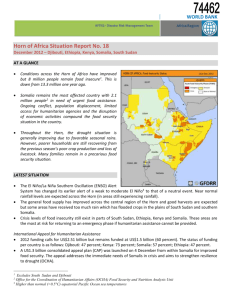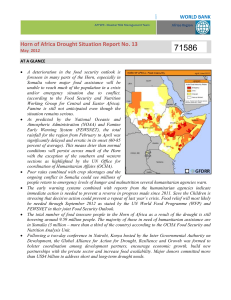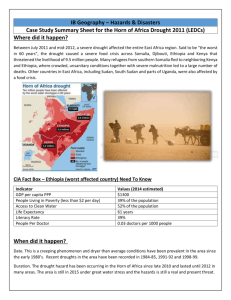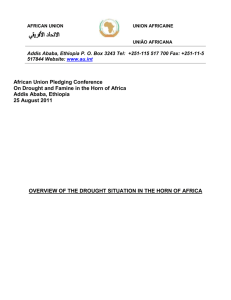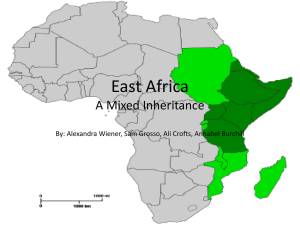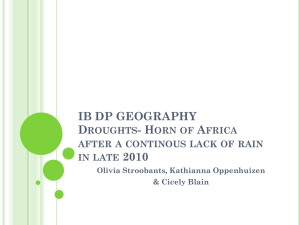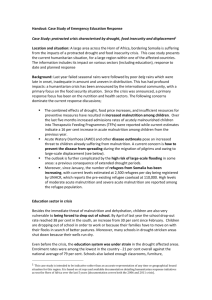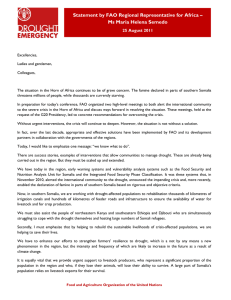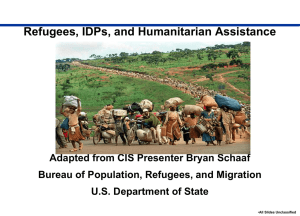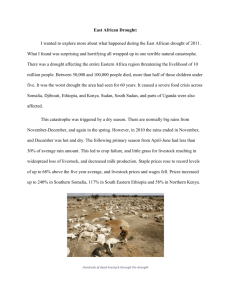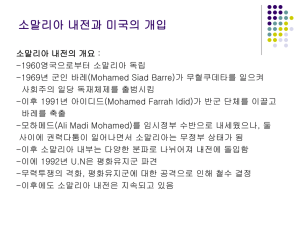HoA sitrep - World Bank
advertisement
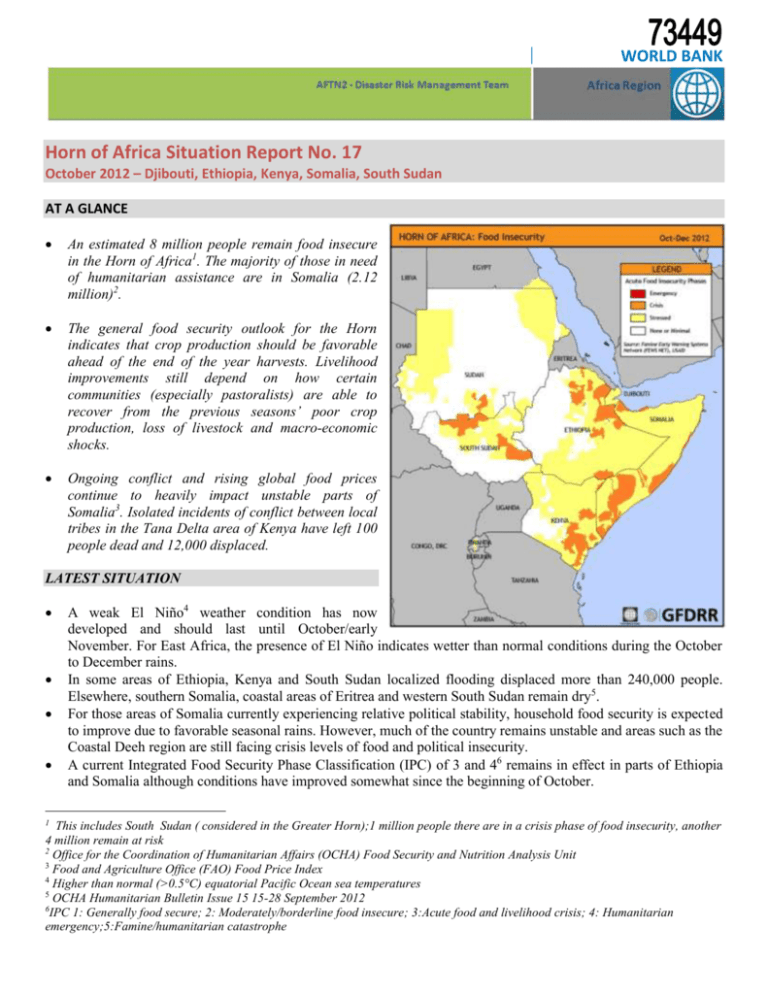
WORLD BANK Horn of Africa Situation Report No. 17 October 2012 – Djibouti, Ethiopia, Kenya, Somalia, South Sudan AT A GLANCE An estimated 8 million people remain food insecure in the Horn of Africa1. The majority of those in need of humanitarian assistance are in Somalia (2.12 million)2. The general food security outlook for the Horn indicates that crop production should be favorable ahead of the end of the year harvests. Livelihood improvements still depend on how certain communities (especially pastoralists) are able to recover from the previous seasons’ poor crop production, loss of livestock and macro-economic shocks. Ongoing conflict and rising global food prices continue to heavily impact unstable parts of Somalia3. Isolated incidents of conflict between local tribes in the Tana Delta area of Kenya have left 100 people dead and 12,000 displaced. LATEST SITUATION 1 A weak El Niño4 weather condition has now developed and should last until October/early November. For East Africa, the presence of El Niño indicates wetter than normal conditions during the October to December rains. In some areas of Ethiopia, Kenya and South Sudan localized flooding displaced more than 240,000 people. Elsewhere, southern Somalia, coastal areas of Eritrea and western South Sudan remain dry5. For those areas of Somalia currently experiencing relative political stability, household food security is expected to improve due to favorable seasonal rains. However, much of the country remains unstable and areas such as the Coastal Deeh region are still facing crisis levels of food and political insecurity. A current Integrated Food Security Phase Classification (IPC) of 3 and 46 remains in effect in parts of Ethiopia and Somalia although conditions have improved somewhat since the beginning of October. This includes South Sudan ( considered in the Greater Horn);1 million people there are in a crisis phase of food insecurity, another 4 million remain at risk 2 Office for the Coordination of Humanitarian Affairs (OCHA) Food Security and Nutrition Analysis Unit 3 Food and Agriculture Office (FAO) Food Price Index 4 Higher than normal (>0.5°C) equatorial Pacific Ocean sea temperatures 5 OCHA Humanitarian Bulletin Issue 15 15-28 September 2012 6 IPC 1: Generally food secure; 2: Moderately/borderline food insecure; 3:Acute food and livelihood crisis; 4: Humanitarian emergency;5:Famine/humanitarian catastrophe International Appeal for Humanitarian Assistance 2012 funding calls for US$2.51 billion but remains funded at US$1.3 billion (52 percent). The status of funding per country is as follows: Djibouti: 40 percent; Kenya: 53 percent; Somalia: 52 percent; Ethiopia: 47 percent. Isolated incidents of conflict in Kenya and South Sudan, combined with the ongoing conflict in Somalia make it difficult for humanitarian agencies to access these areas. The violence has resulted in new displacements within Kenya as well as new refugees entering Kenya and Ethiopia from South Sudan. Disease outbreaks (cholera and hepatitis E) are affecting the Dadaab refugee camps and parts of Somalia. Humanitarian agencies are calling for a scaling up of the response from the water, sanitation and hygiene sectors. Recent violence in the Democratic Republic of the Congo, creating an influx of refugees into Uganda, is also being closely monitored as it may impact the Horn region. Currently, more than 800,000 drought affected refugees are present in the Horn along with another 1.36 million internally displaced (mostly within Somalia). Situation Analysis Although conditions have improved somewhat since the beginning of October, it is important to keep the momentum and focus on drought resilience. COUNTRY BY COUNTRY SITUATION Djibouti The food security situation has been stable since July following favorable rains, humanitarian interventions and donations received during Ramadan. However, the consecutive poor rainy seasons from 2011 and early 2012 continue to impact the pastoralists who are not able to recover as quickly from their loss of assets (mainly cattle). The region of Ali Sabieh remains the most food insecure where recent heavy rains have destroyed assets. Conditions are expected to improve however throughout October with ongoing humanitarian assistance. Ethiopia At present an estimated 3.8 million people will need emergency food assistance through the end of the year due to a combination of drought, poor 2011 harvests, high food prices and occasional flooding in the Afar, Somali, Oromia and Amhara regions. The Government, local Red Cross, UN World Food Programme (WFP) and various Non-Governmental Organizations are the main suppliers of food assistance. The next rainy season (November to January) is predicted to be wetter than normal. As long as heavy flooding does not occur, the additional rains should be favorable to the agricultural season. With favorable Kiremt (summer) rains crops are developing well in most agricultural areas. Livestock conditions have improved as well. However, north and south Wollo and Tigray regions are seeing below normal crop yields. The United Nations High Commissioner Rights (UNHCR) is reporting that 146,810 drought affected Somali refugees are being hosted at six camps in Dollo Ado (6th camp opened in September). Overall, the country hosts 252,610 refugees from Eritrea, Somalia and S. Sudan. Kenya 2.1 million people remain food insecure; a steady decline since 2011. The majority of humanitarian assistance is focused on refugees, small-scale farmers and pastoralists. Crisis levels of food insecurity still exist in the northeastern pastoral areas as well as the southeastern agricultural zone. High maize prices throughout the country will compound food insecurity further. The Kenyan Ministry of Agriculture predicts the year’s maize harvest to be 10-15 percent below the 5-year average; a sign that the late onset of rains in March is still having an impact on the country. Page 2 Kakuma refugee camp in the North is experiencing another influx of people due to conflict and drought in South Sudan. Approximately 96,000 refugees remain in camps. Kenya hosts 566,487 refugees; most of whom are from Somalia fleeing drought and conflict. Somalia Even with the food security crisis easing, 2.12 million people remain in a crisis food security situation with most residing in the southern regions where humanitarian access remains very limited. Another 1.3 million people remain in a stressed food security situation and risk falling into a crisis unless further aid can be deployed. The El Niño effect should have an overall positive impact on the country with improved rains depending on how well these are distributed. Isolated flooding is also expected in certain water catchment areas of the South. The FAO managed Food Security and Nutrition Analysis Unit for Somalia (FSNAU) Quarterly Brief indicates that the total number of people in a food security crisis is likely to remain unchanged in the second half of the year. The agro-pastoral areas of the South (Bay, Juba, Shabelle, Bakook and Gedo) could face deteriorating conditions due to below average rains. Attention should remain on this part of the country. A return to famine conditions is not expected, but humanitarian agencies emphasize that aid must be sustained to prevent a further deepening of the crisis. Prices for maize, sorghum and other staple foods are increasing steadily. UNHCR estimates that 1.2 million people remain internally displaced due to conflict and drought conditions, while 236,000 children are currently severely malnourished (UNICEF). South Sudan 3 million people in the country remain at risk of food insecurity. Crisis food security levels occur along the north-south border of Sudan, with Abyei and South Kordofan most affected. Heavy flooding is occurring in Unity, Upper Nile, Jonglei, Northern Bahr el Ghazal, Warrap and Lakes States negatively impacting crop performance. Conflict amid rising tensions with Sudan has caused more than 200,000 people to be displaced, especially in South Kordofan. Inter-tribal conflict is also creating displacement with many fleeing to refugee camps in Ethiopia. There has been a blockade of trade to the south since May. Even with alternative routes being worked out through Eastern Africa, high food prices and limited availability of food are hurting poorer households which rely almost solely on purchasing food during the lean season. The Yida refugee camp now hosts 60,000 people and averages 300-500 new arrivals daily (UNHCR). Due to the influx, malnutrition rates and child mortality are on the rise. Food prices remain relatively stable but are expected to rise, especially for staple grains. Page 3 WORLD BANK RESPONSE KEY ACTIONS Regional: The HoA Emergency Health & Nutrition Project (US$30 million CRW funds) completed its disbursement in May 2012, greatly benefitting women and children in the Dolo Ado and Dadaab refugee camps. The World Bank continues to work closely with the Global Alliance, initiated by USAID and anchored with IGAD, to develop long-term solutions geared toward building drought resilience. Support to IGAD includes a US$990,000 technical assistance project, financed by a GFDRR grant to strengthen its capacity for implementing the “Horn of Africa Regional Disaster Resilience and Sustainability Strategy Framework”. Related to the work with the Global Alliance and IGAD is the preparation of a US$180 million project to strengthen the resilience of pastoralists in Ethiopia, Kenya and Uganda. A US$430,000 GFDRR grant to the IGAD Climate Prediction and Application Centre (ICPAC) is strengthening the institution and supports the Greater Horn of Africa Climate Outlook Forum (GHCOF) which takes place every 3 months. Ethiopia: 70 federal and regional government staff received training in the Post Disaster Needs Assessment methodology in June 2012. This training included a ‘hands-on’ learning experience and field trip to drought affected Boset Woreda (district). This capacity building exercise enhanced the government’s capacity to conduct drought and other disaster related impact assessments. CRW resources were disbursed to the Productive Safety Net Program to replenish the risk financing facility of the program. Kenya: Kenya Agricultural Productivity and Agribusiness Project: drought related activities are being scaled up in the identified districts. Health Sector Support Project: the project is ongoing and is one of the first projects supporting large scale nutrition interventions targeting the resident populations who are equally vulnerable compared to refugees in the camps. Somalia: The US$9 million Somalia Drought Management and Livelihood Protection Project is supplying 97,008 people with cash-for-work activities for the rehabilitation of productive infrastructure. The project supported an additional 210,000 people in crisis with seeds for drought tolerant crops. All seed distributions were completed. Uganda: No new updates WB Horn of Africa Drought Response Contacts Doekle Wielinga, AFR DRM Coordinator, AFTN2, WB Washington DC, AfricaDRM@worldbank.org Disaster Risk Management Website Sources: OCHA, Relief Web, FEWSNET, UN agencies, press releases from various media sources, WB Staff Page 4
